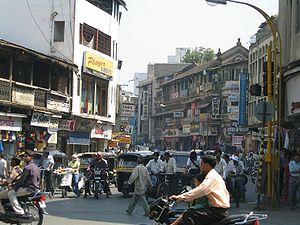
Kasba Peth
Encyclopedia

Pune
Pune , is the eighth largest metropolis in India, the second largest in the state of Maharashtra after Mumbai, and the largest city in the Western Ghats. Once the centre of power of the Maratha Empire, it is situated 560 metres above sea level on the Deccan plateau at the confluence of the Mula ...
, India
India
India , officially the Republic of India , is a country in South Asia. It is the seventh-largest country by geographical area, the second-most populous country with over 1.2 billion people, and the most populous democracy in the world...
and is very adjacent to the historic Shaniwar Wada
Shaniwar Wada
Shaniwarwada is a palace fort in the city of Pune in Maharashtra, India. Built in 1736, it was the seat of the Peshwa rulers of the Maratha Empire until 1818 when the Peshwas surrendered to the British...
palace-fort. Kasba Peth was the first Peth to be established somewhere in the 5th century, and is the oldest area in Pune. It is called the "Heart of Pune City."
Kasba Ganpati the Gram Daivat (root deity) of Pune, is in Kasba Peth. This temple was built in Shivaji Maharaja's reign. Kasba Peth is the only locality in Pune where one can still find the existence of a "Wada (house)
Wada (house)
Wada is a traditional mansion typically in the western part of India.-Examples:* Mangalgad in Dudhanewadi* The wada at Menawali* Shaniwar Wada in Pune, Maharashtra* Vishrambaug Wada in Pune*Raste wada...
" or an old styled living apartment with unique architecture. Kasba Peth is mostly a residential area. A wide variety of shops surround Kasba Peth (Tambat Ali, Shimpi Ali, Vyavahar Ali, Bhoi Ali etc.) . It is well known for the Kumbhar Wada (area of earthen potmakers) and the Tambat Ali (area of brass/copper utensil manufacturers).
There is a story behind the Kasba Ganpati : Some children had brought cows there for grazing and found an idol of Ganapati
Ganesha
Ganesha , also spelled Ganesa or Ganesh, also known as Ganapati , Vinayaka , and Pillaiyar , is one of the deities best-known and most widely worshipped in the Hindu pantheon. His image is found throughout India and Nepal. Hindu sects worship him regardless of affiliations...
. Then they colored this idol and started worshipping it. Shivaji Maharaja's mother Jijabai also visited there whenever she came to Lal Mahal. Hence Dadoji Konddeo
Dadoji Konddeo
Dadoji Kondev was a 16th century revenue expert from India, particularly known for his loyalty towards Shahaji...
built a pendol in front of the idol where the Kasba Ganpati Temple is today.
Kasba Peth is also known as Kumbhar Wada (locality of the earthen pot makers). Skilled metal craftsmen (known as Otari) known for crafting utensils out of brass and copper also reside there.
Lal Mahal and Kasba Ganapati Temple are some of the places of interest.

